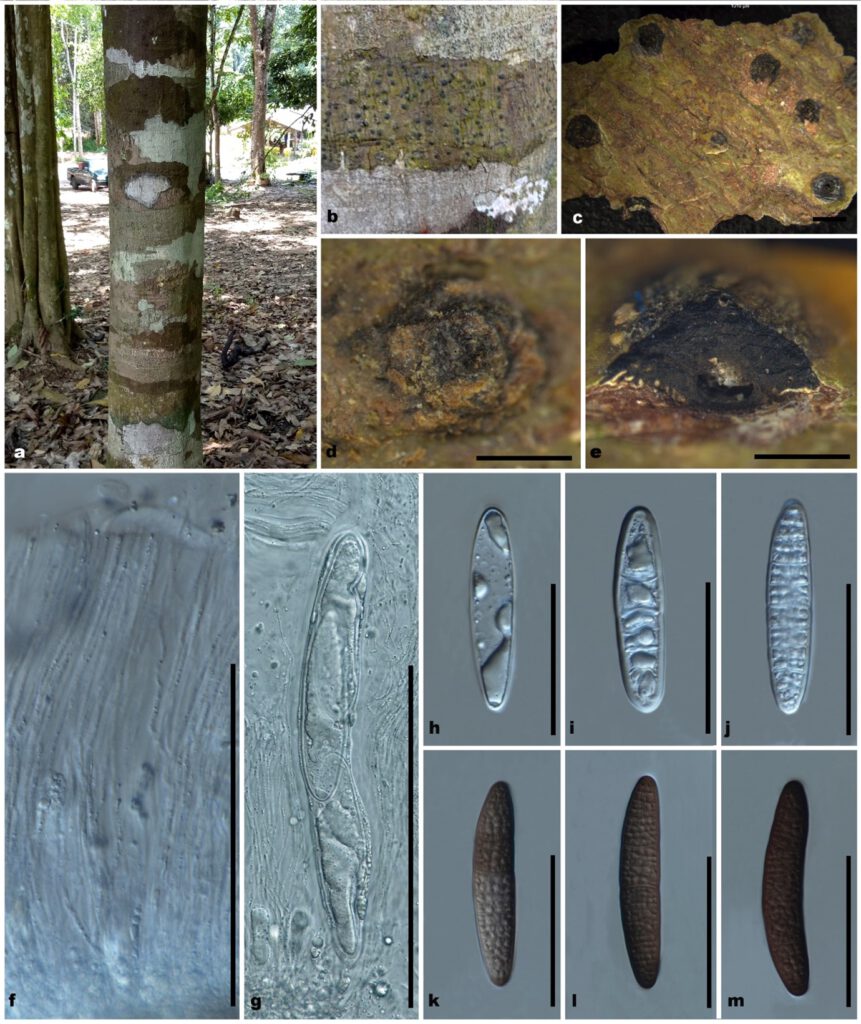Anthracothecium prasinum (Hepp) Müll. Arg., Linnaea 43: 44 (1880)
Index Fungorum number: IF 132203; MycoBank number: MB 132203; Facesoffungi number: FoF 10696; Fig.1
Thallus epi to endoperidermal, pale green, corticated, crustose, continuous, matt to slightly glossy, reflecting bark texture, medulla not apparent. Prothallus present, Photobiont observed. Sexual morph: Ascomata perithecial, 1–2 mm wide, semi-immersed to erumpent, solitary, carbonaceous. Ostiole distinct, apical, papillate. Peridium thickened, carbonaceous, black. Hamathecium comprising filamentous paraphyses and asci, hyaline. Paraphyses numerous, packed, not branched, aseptate, hyaline, filamentous, 0.8–3 μm thickness, generally exceeding the length of asci. Asci 300–340 × 45–55 µm (x̄ = 320 × 50 μm, n = 20), bitunicate, fissitunicate, 2-spored, long cylindrical, tholus thickened, tip blunted, with poorly developed stipe, ascus wall apically thickened, inconspicuous ocular chamber. Ascospores 120–180 × 25–40 µm (x̄ = 150 × 32.5 μm, n = 40), hyaline to brown, oblong to slightly curved, muriform, both ends bluntly tapered, smooth-walled, without gelatinous sheath. Asexual morph: Undetermined.
Material examined – Thailand, Phattalung Province, Pa Phayom, Lan khoi, Hat Yai, elevation 80.5 m, 7.89274 (N 7′ 53′ 33.853″) altitude, 99.7895(E 99′ 47′ 22.206″) latitude, on living bark of Malvaceae, 11 May 2018, V. Thiyagaraja, MFLU 21-0133.
Known distribution (based on molecular data) – Australia (eastern Queensland) and Thailand (Wolseley et al. 2002, Boonpragob et al. 2009, this study).
Known hosts (based on molecular data) – unknown, living bark of Malvaceae (this study).
GenBank accession numbers – ITS: OM320440, LSU: OM296275, mtSSU: OM304350.
Notes – The new collection is phylogenetically closely related to A. prasinum. However, the new collection shows differences in the number of ascospores per ascus (2-spored) in comparison to A. prasinum, which shows 6-8 ascospores per ascus but shares similarities in the apical ostiole, length of asci, and pantropical habitat. The new strain also shares similar morphological features to A. interlatens, in having semi-immersed to immersed, black perithecia, carbonized peridium, 2-spored ascus, and the size of ascospores but differs in the distribution of ascomata (aggregated vs. solitary), the shape of ostiole (shared vs. apical) and size of asci (200–230 × 45–52 µm vs. 300–340 × 45–55 µm) (Joshi et al. 2018). The new collection is recorded on the bark of the Malvaceae tree. However, there is no clear evidence for the host substance of Anthracothecium prasinum. Thus, we provide a comprehensive illustration (Fig. 39), with a detailed description of this species.

Fig. 1. Anthracothecium prasinum (MFLU 21-0133, new collection). a–d Ascomata on substrate, e Vertical section through ascoma, f Paraphyses, g Asci, k–m ascospores. Scale bars a–d = 100 µm, g = 50 µm, h = 30 µm, i–n = 50 µm, o–t = 10 µm
